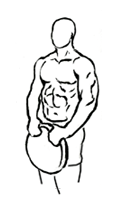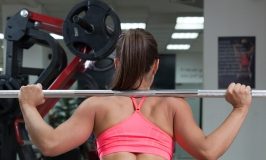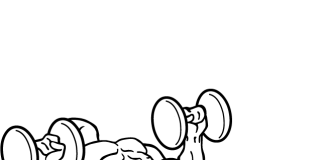Last Updated on December 17, 2014
Reverse Plate Curls with Weight is an excellent exercise to add variety to your arm workout and target the muscles from a unique angle. Unlike traditional curls, which primarily target the biceps, reverse plate curls focus on the brachioradialis (the main forearm muscle) and brachialis (the muscle underneath the biceps), contributing to improved grip strength, forearm development, and overall arm definition.
This exercise involves using a weight plate instead of dumbbells or a barbell, which not only challenges your grip but also engages the wrists, making it a great addition for athletes, lifters, and anyone looking to build functional strength in the forearms and upper arms.
Why Do Reverse Plate Curls?
- Enhanced Forearm Strength: Reverse plate curls target the forearms directly, building strength essential for various sports and daily activities.
- Bicep and Brachialis Development: By engaging the brachialis, this exercise helps build fuller biceps, as it contributes to the appearance of arm thickness.
- Improved Grip Strength: Holding a plate with an overhand grip improves grip strength, beneficial for other exercises like deadlifts, pull-ups, and rows.
- Variety in Arm Workouts: Traditional curls may become repetitive; reverse plate curls introduce a new movement to your routine, keeping your muscles challenged and engaged.
- Wrist Stability: The unique hand positioning in this exercise strengthens the muscles around the wrist, increasing joint stability.
Step-by-Step Guide to Performing Reverse Plate Curls with Weight
Let’s go through the correct technique for Reverse Plate Curls with Weight:
Step 1: Positioning and Setup
- Select the Appropriate Plate Weight: Start with a lighter plate if this is your first time with this exercise. A 5–10 kg (10–20 lb) plate is generally recommended for beginners.
- Stand with Feet Shoulder-Width Apart: Position your feet under your shoulders for balance. Keep your knees slightly bent to reduce strain on the lower back.
- Engage Your Core: Tighten your abdominal muscles to maintain stability and reduce pressure on your lower back.
Step 2: Gripping the Plate
- Hold the Plate with a Pronated Grip (Palms Facing Down): Position your hands at the 11:00 and 1:00 o’clock positions, with palms facing down. This grip is essential for targeting the forearm muscles and maintaining stability throughout the movement.
- Keep a Firm Grip: Ensure that you’re holding the plate securely to prevent it from slipping, as this will also challenge your forearms and grip strength.
Step 3: Curling the Plate
- Position Your Elbows Close to Your Sides: This helps isolate the forearms and biceps, reducing the involvement of other muscle groups.
- Lift the Plate in a Controlled Manner: With a steady and controlled motion, curl the plate upward. Focus on engaging the forearms as you lift, rather than letting other muscles take over.
- Bring the Plate to Chin Level: Aim to raise the plate toward your chin or just below it. Avoid swinging or using momentum to lift the weight.
Step 4: The Lowering Phase
- Pause at the Top: Hold the plate briefly at the top of the movement, focusing on squeezing your forearms and biceps.
- Lower the Plate Slowly: Gradually return the plate to the starting position, maintaining control. Lowering slowly is vital to building muscle as it increases time under tension.
- Repeat for Desired Reps: Aim for 8–12 repetitions, depending on your fitness level and goals.
Muscles Worked During Reverse Plate Curls with Weight
Understanding which muscles are activated can help you focus on the correct areas during the exercise:
- Brachioradialis: The primary forearm muscle responsible for elbow flexion.
- Biceps Brachii: This muscle assists in the lifting motion, helping create arm definition.
- Brachialis: Located beneath the biceps, the brachialis assists in elbow flexion and adds thickness to the upper arm.
- Wrist Extensors: The muscles on the back of the forearm that stabilize the wrist during the movement.
Common Mistakes to Avoid
To maximize the effectiveness of Reverse Plate Curls and prevent injuries, avoid these common mistakes:
- Using Too Much Weight: Many people use a heavy plate, compromising form. Start light, and increase weight only when you can maintain proper technique.
- Bending or Rounding the Back: Keep your back straight, core engaged, and avoid leaning back as you curl.
- Elbows Flaring Out: Keep your elbows close to your body to fully engage the forearms and biceps.
- Swinging or Using Momentum: Lift with control. Swinging the weight reduces tension on the muscles and increases the risk of injury.
- Neglecting the Lowering Phase: Lower the weight slowly, as this phase is crucial for building strength and muscle.
Tips to Maximize Your Reverse Plate Curl Results
Incorporating the following tips can help you get the most out of each rep:
- Focus on Time Under Tension: Slowly lowering the plate after each curl increases the time your muscles are engaged, enhancing muscle growth.
- Breath Control: Inhale as you prepare to curl, and exhale during the lifting phase. Proper breathing improves control and reduces the risk of dizziness.
- Engage the Core: Keep your core tight throughout the movement to stabilize your posture and reduce lower back strain.
- Stretch Between Sets: Gently stretch your forearms and biceps between sets to prevent stiffness and improve recovery.
- Record or Use a Mirror: Watching your form helps identify any inconsistencies, allowing for real-time adjustments.
Variations of Reverse Plate Curls with Weight
Adding variations of Reverse Plate Curls can keep your workout fresh and challenge your muscles in new ways:
- Single-Arm Plate Curl: Use one hand to curl the plate. This isolates each arm, increasing the difficulty and enhancing grip strength.
- Seated Reverse Plate Curl: Sitting on a bench reduces lower back strain and increases focus on the arms.
- Alternating Plate Curls: Use two smaller plates, curling one at a time. This method emphasizes unilateral strength and stability.
- Reverse Dumbbell Curl: Swap the plate for dumbbells to increase the range of motion and engage stabilizing muscles.
- Barbell Reverse Curl: Use a barbell with a pronated grip, making it a compound version that also engages shoulder stabilizers.
Integrating Reverse Plate Curls into Your Workout Routine
The Reverse Plate Curl can be a valuable addition to various types of workouts:
- Arm Day: Include it alongside bicep curls, tricep extensions, and hammer curls for a comprehensive arm workout.
- Upper Body Day: Combine with shoulder presses, chest exercises, and back exercises to work all upper body muscles.
- Forearm Focus: If your goal is to improve grip and forearm strength, pair reverse curls with other forearm exercises like wrist curls or farmer’s carries.
- Functional Strength Training: Since grip strength and forearm stability are essential for functional fitness, add it to routines focused on overall strength.
Sample Workout Routine with Reverse Plate Curls
Here’s an example routine that includes Reverse Plate Curls with Weight:
- Warm-Up: 5–10 minutes of light cardio followed by dynamic arm stretches.
- Reverse Plate Curls: 3 sets of 10–12 reps
- Hammer Curls: 3 sets of 8–12 reps
- Barbell Curls: 3 sets of 8–10 reps
- Tricep Extensions: 3 sets of 10–12 reps
- Wrist Curls (optional): 2 sets of 12–15 reps for forearm endurance
- Cool Down: Stretching the forearms, biceps, and shoulders.
Functional Benefits of Reverse Plate Curls
Building strength in the forearms and biceps has a host of practical applications:
- Grip Strength for Daily Tasks: Everyday tasks that require a strong grip, such as carrying bags or opening jars, become easier with stronger forearms.
- Athletic Performance: Sports requiring grip and arm strength, such as rock climbing, tennis, or martial arts, benefit from forearm and bicep strength.
- Improved Lifting Performance: Strong forearms improve grip, aiding lifts like deadlifts, pull-ups, and rows.
Progression and Increasing Intensity in Reverse Plate Curls
- Increase Weight: Add weight gradually as you master your form to avoid strain.
- Increase Reps or Sets: If you’re comfortable with 10 reps, try for 12–15 reps, or add an extra set.
- Tempo Training: Slow down the lifting and lowering phase, emphasizing control and muscle engagement.
- Superset with Other Forearm Exercises: Pair reverse plate curls with wrist curls or farmer’s carries to build grip endurance and forearm size.
Safety Tips and Precautions
Since the Reverse Plate Curl can place stress on the wrists and elbows, following these safety tips is essential:
- Avoid Hyperextending the Wrists: Keep your wrists in a neutral position to prevent strain.
- Start Light: Begin with a lighter weight to perfect your form before increasing the load.
- Keep Elbows Close: Flared elbows reduce tension on the target muscles and can strain the shoulders.
- Use Padded Plates if Necessary: Weight plates with rubber or padding provide better grip and reduce discomfort.
- Focus on Form Over Weight: Using too much weight can compromise technique, reducing effectiveness and increasing injury risk.
The Reverse Plate Curl with Weight is a versatile exercise that deserves a place in any well-rounded arm or upper body routine. Its unique grip position and focus on the forearms and brachialis make it invaluable for anyone looking to increase arm strength, build grip endurance, or enhance their workout variety. By following proper form, avoiding common mistakes, and gradually progressing, you can maximize the effectiveness of Reverse Plate Curls, adding both strength and aesthetics to your arm muscles.








